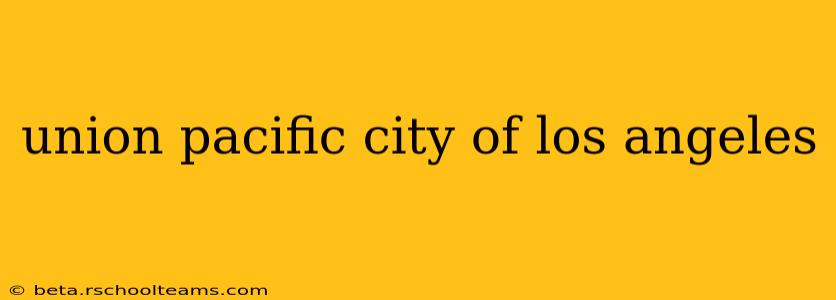The Union Pacific Railroad's "City of Los Angeles" wasn't just a train; it was a symbol of westward expansion, a luxurious mode of transportation, and a testament to the enduring power of the railway. This iconic streamliner, which operated for decades, holds a special place in the hearts of rail enthusiasts and history buffs alike. This post will delve into the history of the City of Los Angeles, exploring its evolution, impact, and lasting legacy.
What was the City of Los Angeles train?
The "City of Los Angeles" was a high-speed, streamlined passenger train that operated between Chicago and Los Angeles, traversing the vast expanse of the American West. Initially introduced in 1936 by the Chicago & North Western Railway (CNW) and Union Pacific Railroad (UP), it represented the pinnacle of luxury and speed for its time. Its sleek, Art Deco design was a striking departure from earlier trains, reflecting a modern aesthetic that captured the spirit of the era. The journey, though long, was celebrated for its comfort and scenic views.
What years did the City of Los Angeles run?
The City of Los Angeles enjoyed a long and illustrious run, spanning several decades. While the exact dates vary depending on specific service iterations and wartime interruptions, the train operated in various forms from its introduction in 1936 until 1971. This remarkable lifespan reflects its enduring popularity and importance as a major transportation link between the East and West coasts.
When did the City of Los Angeles train stop running?
The final curtain fell on the City of Los Angeles in 1971. The decline of passenger rail travel in the face of increasing automobile use and the rise of air travel contributed to its discontinuation. This marked a significant moment in American railway history, signaling a shift away from long-distance passenger trains and the eventual demise of many iconic routes.
What was special about the City of Los Angeles train?
Several factors contributed to the City of Los Angeles's legendary status:
- Speed and Efficiency: For its time, it was exceptionally fast, significantly reducing travel time between Chicago and Los Angeles.
- Luxury and Comfort: Passengers enjoyed spacious accommodations, including comfortable seating, dining cars offering fine meals, and observation cars providing panoramic views.
- Art Deco Design: Its sleek, modern design reflected the aesthetic sensibilities of the era, instantly recognizable and visually stunning.
- Route and Scenery: The route itself was a major attraction, offering passengers breathtaking views of the American West.
Why was the City of Los Angeles train discontinued?
The discontinuation of the City of Los Angeles, like many other long-distance passenger trains, was primarily due to the rise of air travel and the increasing popularity of automobiles. The post-war boom in car ownership and the expansion of the interstate highway system provided Americans with faster and more convenient alternatives for long-distance travel. Additionally, the train service faced financial challenges, with declining ridership and increasing operating costs contributing to its ultimate demise.
What replaced the City of Los Angeles train?
No single entity directly replaced the City of Los Angeles train. Its disappearance left a void in long-distance passenger rail service between Chicago and Los Angeles. While Amtrak later established routes connecting these cities, the luxurious experience and iconic status of the City of Los Angeles have yet to be fully replicated. The discontinuation represents a lost chapter in American railway history.
The Legacy of the City of Los Angeles
The City of Los Angeles, despite its eventual discontinuation, remains an iconic symbol of a bygone era of American rail travel. Its legacy endures in the memories of those who traveled on it, in the photographs and historical records that document its grandeur, and in the continuing fascination with this remarkable piece of railway history. Its story serves as a reminder of the importance of preserving and celebrating our transportation heritage.
